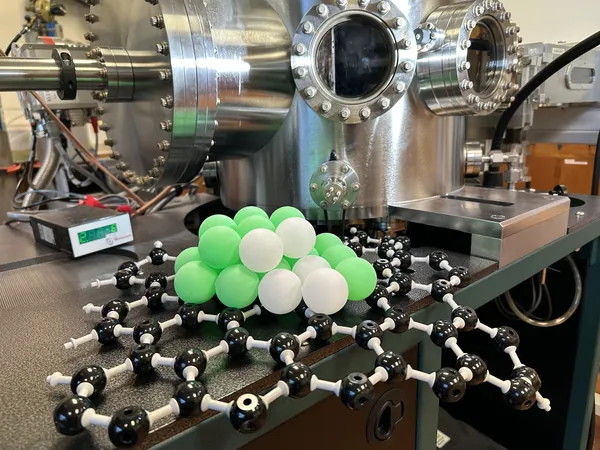
Breakthrough Catalyst Transforms Ammonia into Hydrogen with Unprecedented Efficiency!
2025-01-09
Author: Benjamin
In a remarkable advancement for clean energy, scientists have developed a groundbreaking catalyst that not only enhances hydrogen generation from ammonia over time but also embodies a self-improving mechanism that defies conventional understandings of catalyst behavior.
The innovative research, conducted by a collaborative team from the University of Nottingham's School of Chemistry, the University of Birmingham, and Cardiff University, introduces a novel catalyst made of nanosized ruthenium (Ru) clusters supported on graphitized carbon. This catalyst facilitates the critical reaction of splitting ammonia into hydrogen and nitrogen, paving the way for the production of green hydrogen—an essential component in the global shift toward sustainable energy solutions.
Published in the esteemed journal *Chemical Science*, this research highlights the potential of ammonia as a zero-carbon energy carrier, crucial for driving a new sustainable economy. The need for quick and energy-efficient ammonia cracking processes is paramount, especially with rising energy demands and a pressing need to reduce carbon footprints worldwide.
What makes this catalyst particularly unique is its ability to become increasingly active with use—a phenomenon seldom seen in catalysts, which typically exhibit deactivation over time. Understanding the atomic-level changes that enhance catalyst performance is vital for the development of next-generation materials that can significantly advance hydrogen production.
Dr. Jesum Alves Fernandes, an Associate Professor and co-leader of the project, elaborated on their innovative approach. "Traditional catalysts usually consist of nanoparticles, but many of their atoms are inaccessible for reactions. Our method focuses on utilizing individual atoms that self-assemble into specifically sized clusters, optimizing the surface area for reactions."
The cutting-edge catalyst was created using a process known as magnetron sputtering, which allows for the clean construction of ruthenium nanoclusters without the need for solvents or additional reactants. This environmentally friendly technique maximizes the efficiency of precious materials like ruthenium, common to catalytic processes.
Dr. Yifan Chen, a Research Fellow involved in the study, expressed the team's astonishment at the self-improving nature of the Ru nanoclusters. "Unlike conventional catalysts, which often lose efficacy over time, we found that these clusters actually grow more active. We developed a sophisticated microscopy technique to observe atomic rearrangements during the reaction, revealing that ruthenium atoms reorganize into stable, stepped-edge nano-pyramids."
These nano-pyramids showcase an evolved structure that maintains stability at elevated temperatures and continuously enhances active site density, leading to improved hydrogen production—an aspect that underlines this catalyst's remarkable efficiency.
Professor Andrei Khlobystov from the School of Chemistry at the University of Nottingham underscored the significance of this discovery, stating, "Our findings represent a pivotal shift in catalyst design. This stable, self-improving system for hydrogen generation from ammonia promises to make a meaningful impact on sustainable energy technologies, aiding the transition to a zero-carbon future."
With this monumental scientific achievement, the promise of hydrogen as a clean, renewable energy source grows closer to reality, potentially transforming energy landscapes and contributing to a more sustainable world. Stay tuned as researchers delve deeper into this project, which could usher in a new era of green energy technologies!









 Brasil (PT)
Brasil (PT)
 Canada (EN)
Canada (EN)
 Chile (ES)
Chile (ES)
 Česko (CS)
Česko (CS)
 대한민국 (KO)
대한민국 (KO)
 España (ES)
España (ES)
 France (FR)
France (FR)
 Hong Kong (EN)
Hong Kong (EN)
 Italia (IT)
Italia (IT)
 日本 (JA)
日本 (JA)
 Magyarország (HU)
Magyarország (HU)
 Norge (NO)
Norge (NO)
 Polska (PL)
Polska (PL)
 Schweiz (DE)
Schweiz (DE)
 Singapore (EN)
Singapore (EN)
 Sverige (SV)
Sverige (SV)
 Suomi (FI)
Suomi (FI)
 Türkiye (TR)
Türkiye (TR)
 الإمارات العربية المتحدة (AR)
الإمارات العربية المتحدة (AR)